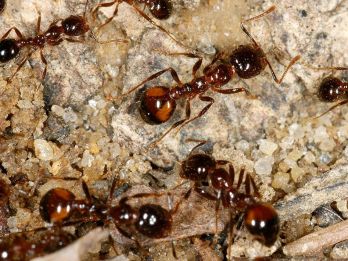Black imported fire ant
Fire ants include several species of ants in the genus Solenopsis. They are only a minority in the genus, which includes over 200 species worldwide.
Fire ants are a ‘super pest’ – aggressive, highly-adaptive and well-equipped for survival.
Background
The black imported fire ant (BIFA, Solenopsis richteri) was long thought to either be a subspecies or colour variation of the red imported fire ant (RIFA, Solenopsis invicta). It is now recognized as its own species, being less dominant with different range and living habits.
Black imported fire ants are native to South America, extending from northern Argentina, throughout Uruguay, and into southern Brazil.
The species was accidentally introduced into the south-eastern United States around 1918.
Impacts
The black imported fire ant is well known for aggressiveness and mound-building behaviours.
They are highly territorial and respond to any threat to the mound with overwhelming force. Swarms of ants pour forth to defend their home, and the pain of their sting is second only to the sheer number of stings delivered by the attacking ants.
Stings of imported fire ants will produce a sterile pustule that is helpful in distinguishing them from the bite of other insects.
Identification
Ants have castes, so there are different types of ant morphologies for each species, such as major workers, minor workers, alate males (winged) and queen ants. Characteristics common to all fire ants include:
- a 2-segmented waist
- an absence of spines on the back of the ant, specifically the propodeum
- a long hair (seta) in the middle of the clypeus, just above the jaws.
Workers have 10-segmented antennae, with the last 2 segments forming a distinct club.
A characteristic seen only among the 2 species of imported fire ant is the median tooth centred along the front edge of the clypeus, which is flanked by 2 lateral teeth.
Black imported fire ants are black or dark brown in coloration with a yellow spot on its gaster.
Habitat
Black imported fire ants prefer open area grasslands, particularly pampas, pastures and lawns. BIFA seem to be more tolerant of cold temperatures than RIFA.
Young colonies prefer moister areas to build their mounds, whereas mature colonies tend to emigrate to drier soil as they grow larger.

